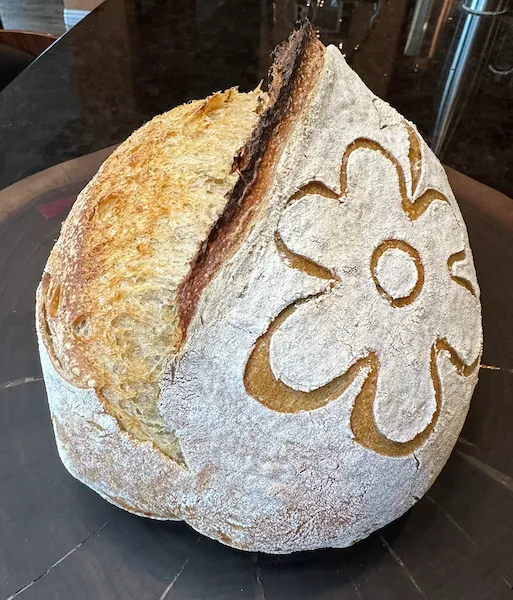
High Hydration Sourdough (80% Hydration)
How to Make a High Hydration Sourdough (80%)
“This loaf is soft, moist and delicious. It's a little harder to handle with the higher hydration, so not for the sourdough beginner.”
I would love more FREE recipes and tips straight to my IN BOX!
This recipe can be used with just a simple score down the middle, or it can be used for more detailed scoring. It can be shaped as a boule or a batard. This high hydration loaf gives you a more open crumb. If you have never made sourdough before, I would recommend starting with our Beginner Artisan Sourdough, Sourdough Sandwich Loaf or No-Knead Sourdough first. Once you master those easier to handle doughs and techniques, you can try this recipe.


Prep Time: 15 min plus stretch and folds (2 hours) and bulk ferment time (4-6 hours)
Cook Time: 30-40 min
Servings: 1 loaf
Ingredients
Preparation Steps
1. To a large mixing bowl, add the ripe, bubbly starter. Pour the water over the starter and mix with a dough whisk until a uniform consistency is obtained.
2. Weigh out your bread flour. Use the dough whisk to combine most of the way. Then, with wet hands, mix completely.
3. Let dough rest for 1 hour. (Fermentalyse) - Use this time to prepare any inclusions you will want to add.
4. Weigh out your salt and add to the fermentalyse in the mixing bowl. Again with wet hands, incorporate the salt until no grains are felt.
5. Let the dough rest 30 minutes. Do your first set of stretch and folds. (S&F #1)
6. Let the dough rest another 30 minutes. Do a second set of stretch and folds. (S&F #2) If you are planning to add inclusions, laminate the dough instead, pulling and stretching as for as you can. Then add your inclusions. Press the inclusions into the dough. Fold the right 1/3 of the dough in just past center. Fold the left side of the dough over the top. Roll the dough up and place it back in your bowl.
7. Let the dough rest another 30 minutes. Perform another set of stretch and folds. (S&F #3)
8. Let rest another 30 minutes. Perform the final set of stretch and folds. (S&F #4) All totaled you are doing 3 sets of stretch and folds and a lamination step. (Or 4 sets of stretch and fold if you are not doing lamination.)
9. Bulk ferment in a warm place (74-78º F) for another 4-6 hours.
10. Shape your loaf as a batard or a boule.
11. Dust your Banneton with Thai rice flour. Place the shaped loaf in your Banneton and cold retard overnight or up to 72 hours in your refrigerator.
12. When you are ready to bake, preheat your oven, with your Dutch Oven inside, to 500º F. While the oven is preheating, freeze your dough. This will make scoring easier and will give more temperature difference when you put it into the hot oven to help with oven spring.
13. Dust your dough with Thai Rice Flour and score.
14. Turn your oven down to 430º F. Bake at 430º F with the lid on for 30 minutes.
15. Remove the lid and bake for another 4-5 minutes uncovered at 430º F.
16. The internal temperature of your dough should be 200º F when fully baked.
17. Remove your bread from the oven and cool on a cooling rack for 2 hours before slicing.
NOTE
To bake a 1/2 loaf (mini loaf):
Preheat your oven to 500º F with your 3.5 QT Dutch Oven inside. (a mini Dutch oven)
Turn the oven down to 430º when you put your bread in.
Bake at 430º F for 20 minutes, covered.
Bake at 430º F for 3 minutes, uncovered or until an internal temperature of 200º F is obtained.
*This is a Sourdough Living original recipe.
NOTE: You can purchase a reusable Bread Mat from Rosehill Sourdough. I chose not to get one through Amazon because a few of the reviews stated that the color came off on their loaf.
Share with Your Friends!
Feel free to share this newsletter with your friends and family, and invite them to join our Facebook group Sourdough Living and subscribe to our newsletter at www.sourdoughliving.com
